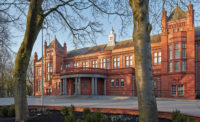Weston Library
View from the Bridge: A major renovation of a stodgy old library carves out new space for the public and increases the building's engagement with the city.


















Architects & Firms
Oxford, England
The New Bodleian Library in the historic center of Oxford had for years been so unfashionable as to be all but invisible. Designed in the mid-1930s by Sir Giles Gilbert Scott (1880–1960) in a stripped-down classical style, and not completed until 1946, it was already a throwback at a time when modernism was rising. Although its rough-textured golden-stone facades became blackened with dirt, and its entrance was always difficult to find, it was nonetheless well proportioned and detailed, sitting on a prominent one-acre corner site. It was just opposite two of this ancient university town’s architectural jewels: the 17th-century Sheldonian Theater by Christopher Wren and the early 18th-century Clarendon Building by Wren’s onetime assistant Nicholas Hawksmoor. Scott’s dowdier building deliberately did not attempt to compete with those masterworks. Yet now, after a $124 million upgrade by architects WilkinsonEyre, it has been turned into a cultural asset for the city. Reborn as the Weston Library, it dares to open up the flank facing its illustrious forbears and has at last become visible.
The Bodleian is an official “deposit library,” collecting everything that is published in the United Kingdom. Dating back to the Middle Ages and expanding piecemeal over time into other buildings—such as Hawksmoor’s and James Gibbs’s circular Radcliffe Camera of 1712–48—its collection is second in size and value only to the British Library in London. Hence the urgent need for massive expansion in the 1930s, which led to Scott’s “New” Bodleian. With its transformation into the Weston Library (named for its sponsor, the Weston Foundation), it is, like the British Library, now both a public museum and a private study center.
Scott conceived his steel-framed, stone-clad building as a central book repository surrounded by reading rooms. As upgraded, it remains a key part of the overall university library system, with an irreplaceable historic collection, restored and new reading rooms, conservation labs, and new fire-protected and compartmented basement stacks for some 2 million books—though the bulk of the stock is now stored in a new warehouse facility off-site. Removing a tower of old book stacks that were a fire hazard allowed Jim Eyre, partner in charge of the project, to make his big move—carving out a large, full-height hall opening off a new colonnade on Oxford’s Broad Street. The colonnade was made by punching out the existing window recesses between engaged square columns on the ground level. Now freestanding, the columns are finished in stone identical to the original, while behind them a new glass entry sits back from the street. Folding ironwork gates seal the colonnade at night. By day, this opens up the building to the public life of the city for the first time; meanwhile, university library readers continue to use the old entrance around the corner.
The atrium that Eyre created in the center of the building—named Blackwell Hall (for another sponsor, a famous Oxford bookshop)—is finished in limestone, roughcast plaster, and timber. In this modern context, an unexpected foil is provided by a 17th-century brick-and-iron gateway on long-term loan from London’s Victoria and Albert Museum and here acting as a threshold between the public areas and private spaces reserved for the university users. On all four sides of the floor above, a glazed gallery of open-access bookshelves overlooks the central hall. But what dominates the space is the two-story volume of study rooms for visiting scholars overhanging the hall–something achieved by inserting a new long-span concrete structure into the heart of the building to replace Scott’s dense steelwork, and supporting it on two concrete service cores rising from the basement.
Eyre designed Blackwell Hall for both university and public events. During the day, visitors can spend time at a café in the hall itself and a shop next to the entrance, or cross the floor to get to exhibition galleries and a lecture theater. A tearoom for university users is set in the northeast corner. In the evening, the hall can be rapidly transformed into a fully catered event space.
If the hall bears the clear modernist signature of WilkinsonEyre, elsewhere Scott is well served: his interiors with their occasional Art Deco touches have been restored, missing wooden light fittings replaced, and his original narrow reading-room desks carefully widened and wired for laptop usage. University users, segregated from the public, move around the building in a circuit, which includes two enclosed bridges spanning Blackwell Hall and linking the two sides of the library.
On the exterior, WilkinsonEyre removed a clumsy postwar rooftop extension and repaired and cleaned the stonework. Scott’s original unpainted aluminum lattice window frames were found to be in excellent condition and have been renovated and reused. The conservative but highly crafted architecture of Scott can now be properly appreciated—and it has proved capable of absorbing a sizable 21st-century structure on the inside while hardly showing it on the outside. In Jim Eyre’s hands, a building that had been strangely mute has finally found its own voice.
Size: 200,150 square feet
Project Cost: $124 million
Construction Cost: $92 million
Completion Date: March 2015
PeopleClient: University of Oxford
Project Manager:
Architect
Personnel in architect's firm who should receive special credit:
Engineers:
M&E Engineer (concept-detailed design):
M&E Engineer (detailed-construction design):
Fire Engineer:
Consultants:
Art Strategy: Modus Operandi
AV Consultants:
Catering:
Catering Design: IFSE
Cost Consultant: EC Harris
Fire Suppression: Frontline Fire
Planning Consultant: Turnberry Consultants
Security: Consort Securities
Specialist Lighting: DHA
Visitor Profile Study:
Wayfinding & Signage: Holmes Wood
Contractors:
Architectural Metalwork: Delta Fabrications
Commissioning: Dome Consulting
Demolition: Keltbray
Display Showcases: Goppion
Dry Lining: Fireclad Fire: R&S Fire
Flooring: AC Plc
General Joinery: Swift Crafted
Glazing: OAG Heritage Joinery: OUES DLO
Lecture Theatre Seating: Figueras
Logistics: Elliott Thomas
M&E Contractor: MJ Lonsdale
Roofing: Imperial Roofing Security: AIS
Shelving: Forster Ecospace
Specialist Joinery: Opus Magnum
Specialist Plaster: G Cook & Sons
Stonework: Putney and Wood
Sub-superstructure (concrete): Byrne Bros Superstructure (steelwork): Graham Wood
Wayfinding and Signage: Rivermeade |
Products
Structural system
Exterior cladding Metal/glass curtain wall: Original aluminum windows refurbished and reglazed.
Roofing
Windows
Glazing Skylights: Concealed aluminum framed double glazed units
Doors Wood doors: Existing sapele veneered timber doors reburbished and refinished. New European oak doors – Shadbolt. Sliding doors: Patinated burnished brass framed glazed doors – Secco Sistemi Ebe System Fire-control doors, security grilles: Guardian Fire Shutters and Fire Curtains Special doors: Burton Security doors.
Hardware Pulls: Bespoke pull handles by John Planck Ltd
Interior finishes Cabinetwork and custom woodwork: Bespoke joinery by Opus Magnum and Swift Crafted Ltd. Paints and stains: Dulux Floor and wall tile: Jura beige limestone flooring to entrance hall flooring Resilient flooring: Forbo Marmoleum Carpet: Desso Flux Special interior finishes unique to this project: Felt float plasterwork and polished plaster by George Cook & Sons
Furnishings Reception furniture: Bespoke by Opus Magnum Fixed seating: Lecture theatre seating by Figueras Chairs: Design by Barber Osgerby / Manufacture by Isokon Plus. Tables: Design by Wilkinson Eyre / Manufacture by Opus Magnum. Other furniture: Bespoke desks, reception tables, and reserve counters by Opus Magnum, exhibition Cases by Goppion
Lighting Task lighting, exterior: Aktiva Dimming System or other lighting controls: Dynalite
Conveyance
Energy
Other unique products that contribute to sustainability: Since it is inherently more sustainable to reuse an existing building (as the reuse of materials and building structure inherently reduces the embodied energy of the building), listing status has an indirect environmental benefit. Notwithstanding this, the limitations placed on the reuse of listed buildings also restricts the extent of intervention that might be carried out to improve their sustainability and energy consumption performance. Despite this, measures therefore have to be taken where appropriate and incorporated into the proposals and the project is currently on target to achieve BREEAM Very Good. As a result of the proposed energy efficiency measures there will be a 13.6% reduction in energy consumption compared to the baseline (the existing building). In addition, the installation of 42.5m2 evacuated tube solar thermal collectors will result in further energy savings of 0.9%. |











